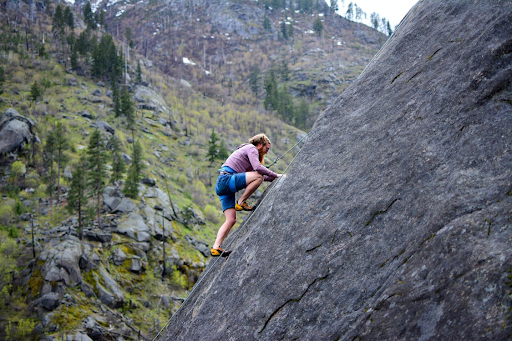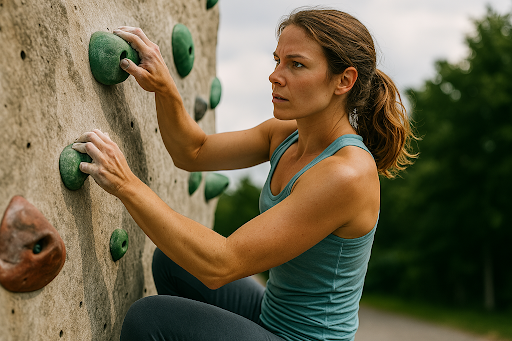How Rock Climbing Transforms Your Body: Muscles, Endurance, and Grip Strength
Rock climbing isn't just about scaling cliffs or hanging from your fingertips on a boulder problem. It rewires your body. Shifts how you move. Sharpens your mind too. Whether you're on plastic indoors or out on the real stuff, the gains? Wild. And it's not just strength we're talking about. It’s the whole package: power, mobility, control, and that rare combo of mental and physical grit. Interestingly, even people who unwind with
AviaMasters are finding their way to the wall these days – sometimes swapping digital thrills for a more physical kind of challenge and release.

The Muscle Makeover
Climbing is a full-body workout in disguise. From your fingertips to your toes, almost every muscle joins the party. And it's not the bulky gym look you get. It's lean, dense, functional muscle. Think wiry strength.
Upper body takes a beating, sure. Lats, traps, biceps? All pulling you up. But forget the myth that it’s just about arms. Core is king in climbing. Obliques, abs, and lower back fire constantly to stabilise your body, keep you tight on the wall. Legs? Hugely underrated. Calves engage on tiny footholds, quads and glutes push you upwards when arms are shot.
Over time, this builds a unique kind of physique. One built for tension, for dynamic movement and control. You start to notice changes after just a few sessions a week. Climbing doesn't isolate muscles like machines do. It integrates them. That’s why results feel natural, almost athletic.
Endurance: More Than Just Stamina
Climbing trains endurance differently. You don't just jog in place for half an hour. You hold tough positions. You shake out while hanging one-armed. You problem-solve while your forearms burn. That’s a different beast altogether.
It builds both aerobic and anaerobic endurance. Think long sessions on vertical routes? Your heart rate stays up, breathing controlled, muscles under constant load. Over time, your cardiovascular system adapts. You breathe easier. Recovery quickens. You go for longer.
Anaerobic endurance kicks in during intense sequences. Short bursts. Explosive moves. Deadpoints, dynos, cruxes. Your body learns to buffer lactic acid, to delay the pump, to stay sharp when it hurts.
And yes, endurance isn't just physical. Climbing forces you to endure mentally too. To stay focused mid-fall. To try again and again when you're cooked. That resilience? It transfers to life beyond the wall.
Grip Strength: The Real Game Changer
Nothing changes more noticeably than your grip. Hands that once struggled to open a jam jar start crushing crimps and pinches like it’s nothing. It’s raw, primal power. And it doesn't just look cool – it protects you. From injury. From slips. From giving up too soon.
Grip strength comes in flavours. Crimping, open-hand, pinch, sloper. Each stresses the hand differently. Climbing forces you to develop them all. Over time, your fingers become iron. Tendons thicken. Wrists get stable. Elbows hold out longer.
Want to boost your climbing? Work the grip off the wall too:
• Hangboarding: Static holds to build tendon strength.
• Farmer's carries: Great for wrist and forearm stability.
• Rice bucket drills: Weird but effective for full-range hand strength.
Combine these with climbing, and progress gets real fast. But go steady. Fingers are slow to adapt. Train smart. Rest matters.

Flexibility and Mobility: The Silent Boost
Not as flashy as muscle, but just as key. Flexibility lets you hit wide stems. High steps. Twisty beta. Without it, you’re stiff. Struggling. Burning energy. With it? You flow.
Hips take centre stage here. Open hips mean better drop knees, better balance. Shoulders too. Mobile shoulders reduce injury risk, allow smoother movement. Ankles? Often overlooked. But crucial for edging and smearing.
Stretching routines can work wonders:
• Dynamic warm-ups: Leg swings, arm circles, hip openers.
• Post-session static stretches: Target hip flexors, calves, forearms.
• Yoga or mobility flows: Build control, breathing, and recovery.
Climbers who stretch climb better. It's that simple. Flexibility isn’t soft. It’s a weapon.
Mental Gains That Mirror the Physical
You can't talk climbing without talking headspace. Fear of falling. Pressure of flashing a project. Staying focused when pumped. These mental battles sculpt a sharper, more confident you.
Climbing boosts spatial awareness. Teaches problem-solving under stress. Builds patience. You learn to fail without frustration. To fall with grace. To keep trying. Again and again.
Confidence grows too. Every route topped. Every grade unlocked. It adds up. Makes you walk taller off the mat.
Mental strength in climbing comes from:
1. Consistent exposure: Fear fades with repetition.
2. Breath control: Calms nerves, conserves energy.
3. Visualisation: Run the route in your head before you pull on.
4. Focus drills: Limit distractions. Build concentration.
Train the mind like you train the body. Because on the wall, they’re one.
Injury Resistance and Longevity
Climbing seems risky. But done right, it builds a bulletproof body. Joints stabilise. Tendons adapt. Muscles balance each other. The body becomes its own armour.
Common climbing injuries come from overuse, not impact. Finger tweaks, elbow pain, shoulder impingements. Most are preventable. Smart training and active recovery make a huge difference.
To stay climbing long-term, do this:
• Warm up properly. Don’t skip it.
• Antagonist training: Push-ups, rows, reverse wrist curls.
• Rest days: Your gains grow in recovery, not just effort.
• Listen to niggles: Treat small pains early.
Prehab > rehab. A few simple habits keep you climbing strong for years.

Final Thoughts
Rock climbing isn’t just a sport. It’s a body-mind overhaul. Muscles evolve. Endurance explodes. Grip becomes gorilla-tier. But it’s the combo that makes it special. Functional strength, control, mobility, focus – all trained at once.
And the best part? It's fun. You don't count reps. You chase routes. You solve puzzles. You get better without even realising it.
So if you’re thinking of trying it, do. The wall changes you. One move at a time.


